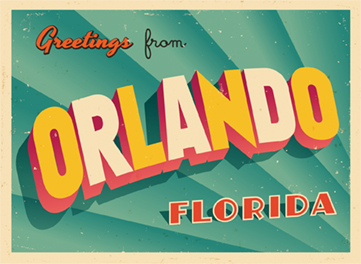Kent McKee remembers when I-4 ended in Sanford and much of the area was dirt roads. He also remembers when citrus trees outnumbered houses in what is now called Windermere. McKee is a fifth-generation Orlandoan who says he’ll stay in Central Florida until his dying day.
His mother BettyJean Lindsay McKee, is part of one of Orlando’s founding families, the Dann family. Her mother, Ethel Dann Lindsay, grew up in downtown Orlando at the turn of the century. In fact, she was baptized in Lake Lucerne.
Now 94 years old and living at The Mayflower Retirement Community, BettyJean has fond memories of Orlando, many of which she passed down to her son. One of the Dann family’s biggest contributions to the area came from BettyJean’s uncle Carl Dann Sr. He founded a little golf course in College Park called Dubsdread Country Club in 1924.
McKee delicately explains that Dann Sr. started the historic golf course because many country clubs had limits on who could join at that time. “Times have changed a lot, but back then my great uncle was pretty progressive,” he says. “He was a very open, generous man. He had friends from all walks of life, from all over the area.”
Cows and Fish
In the ‘60s, southwest Orange County and most of Osceola County were fruit trees and cows. “Kissimmee was cattle country, a real cow town, when I was a kid,” McKee says. “You can still get a sense of what it was like during the annual Silver Spurs Rodeo.”
Generations of cattle families live in that area too. Summerlin, Overstreet and Bronson are just a few of the names that lead the cattle industry there.
Many who have been in Central Florida for generations say the introduction of Walt Disney World in 1971 was the big turning point for the area. But Michael Perkins, executive director for the Orange County Regional History Center (OCRHC), says the area was already a popular vacation spot long before Disney came to town. The woods and lakes were big draws with hunters and fishermen from all over the country.
Kent agrees. Growing up in Winter Park, he loved to go fishing at Lake Sue near Leu Gardens and has continued the family tradition by teaching his two sons how to fish there as well.
“Back then, you could ride your bike with friends from the neighborhood and come home when it was getting dark,” McKee says. “You never had to worry about anything bad happening.”
While he understands that with progress and growth there can be a loss of community, he says he feels most Orlandoans, native or not, try to stay connected with their neighbors. He recalls exactly when he felt a shift back to old Orlando neighborliness.
“After Hurricane Charley people were all looking out for each other,” he says. “We made sure everyone was OK and helped out wherever we could. It was a tragic event for some, but I feel like it brought us all closer together.”
Staying Put
While there are still a handful of families that can trace their Orlando roots to the heyday of agriculture, ranching and land development, Perkins says families no longer found the high-tech industries that now drive the area. Consequently, there is a more transient nature to Central Florida’s population.
That’s part of the reason OCRHC is so relevant. The mission of the center is to collect, preserve, and interpret the material history of Central Florida.
“So much of human life derives from the shared experience of participating in something together,” Perkins says. “[OCRHC] acts as the chroniclers and caretakers of where that adventure has gone and of where it’s going.”
For McKee, his family’s history is not the only reason he stays in Orlando, but it does factor in to it. “My family has been here for five generations,” he says. “We have a long-term relationship with Orlando. I believe in that. That’s why I stay. That, and I love Orlando.”
But McKee also knows that his own sons may find it necessary to move out of the area some day. “I would like them to stay, but I know how lucky and unusual it is for families to stay in one area generation after generation,” he says.
Family Life
Michael Hanley has lived in Dr. Phillips for nearly 30 years. He fell in love with Dr. Phillips not just because of the great real estate but also because of the people. He says he stopped in at Holy Family Catholic Church for mass one Sunday and was greeted warmly by two gentlemen. Those men have remained his friends, and he and his entire family are parishioners at the church.
Hanley, who is a longtime member of the Dr. Phillips Rotary, says he believes the main draws to Dr. Phillips are the Bay Hill Golf Club, the lovely homes, the town’s proximity to downtown Orlando and the theme parks, and the family feel of the area.
Besides Apopka Vineland Road being home to the area’s nicest suburbs, Hanley jokingly says, “If you can’t find God here, you aren’t looking hard enough.”
There are Catholic, Lutheran, Methodist, Mormon, Jewish, Hindu and Muslim places of worship on Apopka Vineland Road. Hanley says having so many people from different faiths living in the area is evidence of the open, friendly atmosphere of Dr. Phillips.
According to Hanley, it’s only been in the last 10 years that Sand Lake Road has become a food mecca for Southwest Orange County. Back in the ‘90s, there a grocery store and a drug store and not much else.
Hanley reflects on feeling lucky that he chose Dr. Phillips as his home back when it was still a hidden gem. He says, “Today the traffic in Dr. Phillips isn’t much fun, but it’s a trade-off to have a nearby hospital, so many great restaurants, a YMCA with a splash pad and activity center, lots of places of worship and great neighbors.”






Comments